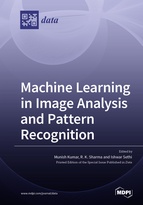Machine Learning in Image Analysis and Pattern Recognition
A special issue of Data (ISSN 2306-5729). This special issue belongs to the section "Information Systems and Data Management".
Deadline for manuscript submissions: closed (30 June 2021) | Viewed by 35647
Special Issue Editors
Interests: feature extraction; image classification; artificial intelligence
Special Issues, Collections and Topics in MDPI journals
Special Issue Information
Dear Colleagues,
Images are ubiqutous. Tens of millions of images are captured everyday for a variety of applications in almost all domains of human endeavors. We have come to rely on machine learning, including deep learning, to analyze and extract actionable information from captured images via recgnizing the presence of patterns of interests. In recent years, these methods, particularly those using deep learning, have exhibited performance levels surpassing human performance in certain applications.
The purpose of this Special Issue is to chart the progress in applying machine learning, including deep learning, to a broad range of image analysis and pattern recognition problems and applications. To this end, we invite original research articles making unique contributions to the theory, methodology, and applications of machine learning in image analysis and pattern recognition. We also welcome comprehensive survey articles dealing with any particular aspect of machine learning vis-à-vis image analysis and pattern recognition.
Dr. Munish Kumar
Dr. R. K. Sharma
Prof. Dr. Ishwar Sethi
Guest Editors
Manuscript Submission Information
Manuscripts should be submitted online at www.mdpi.com by registering and logging in to this website. Once you are registered, click here to go to the submission form. Manuscripts can be submitted until the deadline. All submissions that pass pre-check are peer-reviewed. Accepted papers will be published continuously in the journal (as soon as accepted) and will be listed together on the special issue website. Research articles, review articles as well as short communications are invited. For planned papers, a title and short abstract (about 100 words) can be sent to the Editorial Office for announcement on this website.
Submitted manuscripts should not have been published previously, nor be under consideration for publication elsewhere (except conference proceedings papers). All manuscripts are thoroughly refereed through a single-blind peer-review process. A guide for authors and other relevant information for submission of manuscripts is available on the Instructions for Authors page. Data is an international peer-reviewed open access monthly journal published by MDPI.
Please visit the Instructions for Authors page before submitting a manuscript. The Article Processing Charge (APC) for publication in this open access journal is 1600 CHF (Swiss Francs). Submitted papers should be well formatted and use good English. Authors may use MDPI's English editing service prior to publication or during author revisions.
Keywords
- Computer vision
- Document image analysis
- Face, gesture, and body pose recognition
- Image classification and clustring
- Image segmentation and shape analysis
- Image matching and retrieval
- Image synthesis
- Medical, biological, and cell microscopy
- Multimedia processing
- Object detection, recognition, and tracking
- Representation learning
- Semantic segmentation
- Texture analysis






